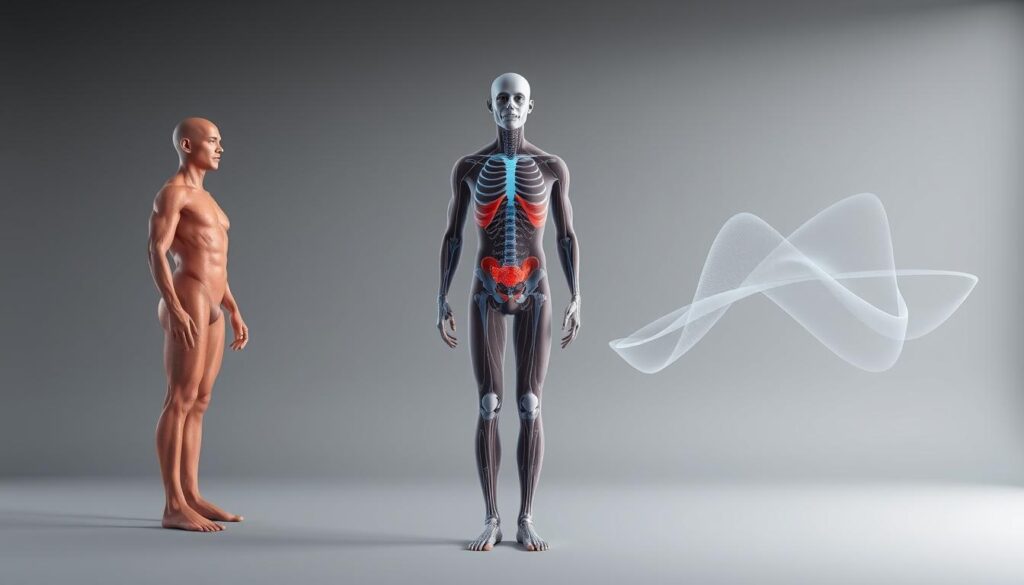For years, Body Mass Index (BMI) has been key in checking health. But, its limits have started a big debate. BMI sorts people into health risk groups, but it misses muscle, bone density, and body makeup. This can cause wrong health advice.
We’re looking into BMI’s flaws and finding promising new ways to see health. Metrics like waist-to-hip ratio and body fat percentage are getting more attention. They might give a clearer picture of health. In this article, we’ll look into these options, seeing how they stack up against BMI.
Key Takeaways
- BMI has big flaws, like ignoring muscle or body shape.
- Metrics like waist-to-hip ratio and body fat percentage are being looked at.
- These new tools might give a better health risk check.
- Knowing about BMI’s alternatives can help in giving better health tips.
- A more detailed health check is needed for accurate grouping.
Understanding Body Mass Index (BMI)
Healthcare experts have used Body Mass Index (BMI) for years. It’s a simple way to check if someone’s weight is healthy based on their height and weight.
What is BMI and how is it calculated?
BMI is found by dividing your weight in kilograms by your height in meters squared (kg/m^2). This formula gives a basic idea of if your weight is healthy for your height. For example, a BMI between 18.5 and 24.9 is usually seen as a healthy weight. A BMI of 30 or higher is considered obese.
Example of BMI Calculation: If someone weighs 70 kg and is 1.75 m tall, their BMI is 22.86. This shows they have a healthy weight.
The role of BMI in health assessments
BMI is easy to use and calculate, making it a common tool in health checks. It helps doctors spot weight-related health problems quickly. But, it’s not meant to be the final say in health.

Limitations of using BMI as a health measure
BMI has its downsides. It can’t tell the difference between muscle and fat. For instance, athletes with lots of muscle might have a high BMI but not be overweight. This shows the BMI limitations in truly measuring health.
BMI also doesn’t look at body composition or fat distribution. This can lead to wrong classifications. People with a lot of body fat might be seen as having a healthy weight by BMI alone. So, it’s important to look at body composition analysis and other health metrics for a better health check.
It’s key for both doctors and people checking their health to know BMI’s limits. By understanding these, we can use a more complete way to check health. This includes looking at measuring body fat and waist size.
Alternative Metrics for Health Assessment
BMI has its limits, leading to the search for better health metrics. Now, we look at waist-to-hip ratio, body fat percentage, and waist circumference. These are becoming key in understanding health better.
Waist-to-Hip Ratio: A Closer Look
The waist-to-hip ratio shows health risks tied to belly fat. It’s found by dividing waist by hip size. Research shows it’s a good sign of heart disease and death risk (Nurse Journal).
- Shows how fat is spread and health risks.
- Is better at predicting heart disease risk than BMI in some cases.

Body Fat Percentage: More Than Just Numbers
Body fat percentage measures body fat compared to lean body mass. It’s different from BMI because it separates fat from muscle. This means athletes with lots of muscle might have a high BMI but not be overfat.
Health Weight Calculator says body fat percentage is a better health indicator. This is true, even for those with a lot of muscle.
Waist Circumference: An Important Indicator
Waist circumference is a simple but effective measure. It shows belly fat, which is linked to diabetes and heart disease. Measuring it gives quick insights into health risks from belly fat.
- Measure around the narrowest point between the lower rib and the iliac crest.
- Values above 35 inches for women and 40 inches for men show higher health risks.
Advantages of Using Alternative Metrics
Exploring alternatives to BMI shows many benefits. Traditional BMI measurements are common but don’t fully show an individual’s health.
New metrics like waist-to-hip ratio and body fat percentage give a deeper look at health risks and body shape. For example, a study found waist-to-hip ratio is better at showing obesity-related health risks.
Improved Accuracy in Assessing Health Risks
Alternative metrics are better at showing health risks. Waist-to-hip ratio, for instance, shows visceral fat levels. This is linked to higher risks of diseases like diabetes and heart disease.
Let’s compare BMI and waist-to-hip ratio for health risk assessment:
| Metric | Health Risk Assessment | Example |
|---|---|---|
| BMI | General indication of health risk based on weight and height | A BMI of 30 indicates obesity |
| Waist-to-Hip Ratio | More specific indication of health risk based on body fat distribution | A waist-to-hip ratio of 0.9 for men or 0.85 for women indicates increased health risks |
Addressing Body Composition: Muscle vs. Fat
These metrics also help tell muscle from fat, a big plus over BMI. Body composition analysis, like lean body mass and body fat percentage, gives a detailed health picture.
For example, athletes with lots of muscle might have a high BMI but not be at risk. Body fat percentage gives a clearer health picture.

Cultural Relevance and Individual Factors
Also, these metrics are more fitting for different cultures and consider personal factors like age and sex. Waist circumference, for example, is simple and works for many people.
Using an online calculator that looks at BMI, waist circumference, and body fat percentage gives a full health check.
When to Use BMI vs. Alternative Metrics
Understanding when to use BMI and when to choose other metrics is key. This helps us get a better picture of our health.
BMI is common for health checks, but it has its limits. New metrics offer deeper insights into our health.
Situations Where BMI is Still Useful
BMI is still useful in some cases. It’s good for quick health checks or big studies. It’s easy and cheap to use.
For example, BMI helps spot obesity risks in groups. This helps health officials plan better.
Key scenarios where BMI is still useful include:
- Initial health screenings
- Large-scale epidemiological studies
- Monitoring changes in population health trends over time
Guidelines for Choosing the Right Measurement
Choosing the right health check depends on what you want to know. For a detailed look at health risks, other metrics might be better.
Metrics like waist size or body fat percentage are better for some. They consider muscle and body shape.
| Metric | Usefulness | Limitations |
|---|---|---|
| BMI | Quick, cost-effective, useful for large-scale studies | Does not account for muscle mass or body composition |
| Waist Circumference | Provides insight into visceral fat and health risks | May not be as straightforward to measure accurately |
| Body Fat Percentage | Offers a more nuanced view of body composition | Requires specialized equipment for accurate measurement |
Consulting Healthcare Professionals for Guidance
Healthcare experts should guide your choice between BMI and other metrics. They know what’s best for you based on your health.
Talking to health experts helps you understand your health better. This way, you can make smart choices for your well-being.
Conclusion: Rethinking Our Health Metrics
Looking into health assessments, we see BMI isn’t enough. We’ve looked at tools like body fat percentage and lean body mass for a better view of health.
Embracing a Broader Perspective
Health is more than just numbers. It’s about physical activity, nutrition, and mental health too. Using body fat percentage and waist circumference helps us understand our health risks better.
Empowering Informed Choices
Learning more about health is key. Knowing BMI’s limits and the value of other metrics helps us make better choices. This leads to healthier lifestyles.
We aim to create a culture that values well-being. Using different health tools helps us make informed decisions and live healthier.


